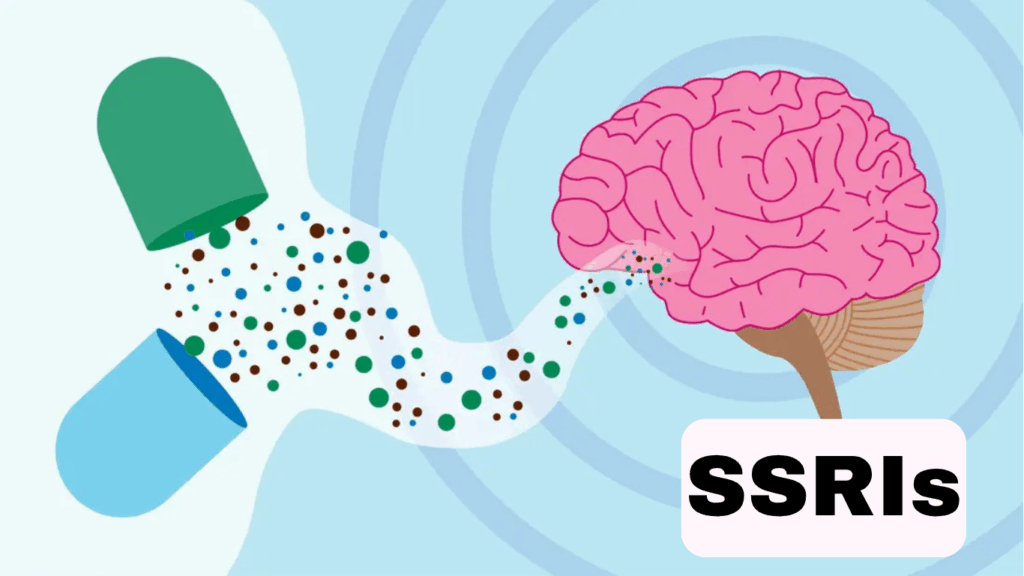Introduction To SSRIs
Selective serotonin reuptake inhibitors (SSRIs) are among the most commonly prescribed antidepressants around the world. They’re often the first choice for treating depression, anxiety, and related disorders. In this article we’ll explore how they work, the main types available, the benefits they offer, and the side effects and risks to watch for. The goal is to give you a complete, easy‑to‑digest overview.
What Are SSRIs?
SSRIs are a class of medications designed to specifically target serotonin, a chemical messenger in the brain that plays a crucial role in mood regulation. Unlike earlier antidepressants, SSRIs act selectively on serotonin without significantly affecting other neurotransmitters. This selectivity makes them generally safer and more tolerable than older drugs such as tricyclic antidepressants (TCAs) or monoamine oxidase inhibitors (MAOIs) .
These medications are prescribed for conditions such as major depressive disorder (MDD), generalized anxiety disorder (GAD), obsessive-compulsive disorder (OCD), panic disorder, PTSD, social anxiety, bulimia nervosa, PMDD, and some off-label uses like premature ejaculation or fibromyalgia .
How SSRIs Work (Mechanism of Action)
Serotonin Reuptake Inhibition
SSRIs inhibit the serotonin transporter (SERT) at the presynaptic neuron. By doing so, they prevent serotonin from being reabsorbed, increasing its availability in the synaptic cleft, and strengthening its signaling at the postsynaptic receptors.
Downstream Neural Effects
Though SERT inhibition happens within hours, mood improvement often takes 4–6 weeks. This delay reflects downstream changes such as receptor regulation, gene expression adjustments (including brain‑derived neurotrophic factor, BDNF), and neuroplasticity. For instance, escitalopram uniquely binds allosterically to SERT and promotes slower dissociation, which may support its efficacy and tolerability.
Selectivity and Tolerability
SSRIs minimally affect norepinephrine, dopamine, histamine, acetylcholine, and other systems (except paroxetine which has modest anticholinergic effects). That selectivity reduces side effects like sedation, dry mouth, or cardiovascular effects common in TCAs and MAOIs.
Types of SSRIs
Here are the main SSRIs used in clinical practice:
-
Fluoxetine (Prozac): long half‑life, mild stimulant effects, may increase norepinephrine/dopamine slightly at higher doses.
-
Sertraline (Zoloft): associated with mild activating effects; some affinity for sigma‑1 receptor and dopamine transporter at high doses.
-
Citalopram (Celexa) and Escitalopram (Lexapro): escitalopram is the active enantiomer and highly selective for SERT, often best tolerated .
-
Paroxetine (Paxil): potent SSRI, more sedating, risk of weight gain and withdrawal symptoms.
-
Fluvoxamine (Luvox): higher rates of gastrointestinal side effects, sometimes used for OCD .
-
Vilazodone (Viibryd): SSRI with partial 5‑HT1A agonist properties, classified as a serotonin modulator rather than pure SSRI.
Advantages of SSRIs
Better Tolerability
Compared to older classes, SSRIs cause fewer anticholinergic effects, less sedation, lower cardiotoxicity, and less cognitive impairment, making them more acceptable for long-term use.
Safety in Overdose
SSRIs are relatively safer in overdose compared to TCAs, which can cause fatal heart rhythm disturbances. This safety profile makes SSRIs a safer option for people at risk of self-harm.
Versatility
SSRIs are approved or commonly used for many disorders beyond major depression—such as anxiety conditions, OCD, PTSD, bulimia, PMDD, and others .
Patient Adherence
Because of milder side effects and once‑daily dosing, patients are more likely to adhere to SSRIs vs older antidepressants, improving long‑term outcomes and cost‑effectiveness .
Common Side Effects
While SSRIs are generally well tolerated, most patients experience some adverse effects, particularly early on or at higher doses:
-
Gastrointestinal upset: nausea, diarrhea, indigestion—especially with fluvoxamine .
-
Insomnia or somnolence: fluoxetine and paroxetine can be activating or sedating depending on dose and timing .
-
Sexual dysfunction: reduced libido, difficulties reaching orgasm, erectile dysfunction—occurs in up to 55% or more; paroxetine has higher incidence, citalopram somewhat lower .
-
Weight changes: initial weight loss may reverse with longer-term use, some gain significant weight over months (up to ~10 kg) .
-
Sleep disruption: REM sleep suppression or efficiency changes; sertraline may preserve sleep better than others.
-
Withdrawal (discontinuation syndrome): dizziness, nausea, lethargy, “brain zaps,” flu-like symptoms if stopped abruptly—most common with short‑half‑life SSRIs like paroxetine .
-
Drug interactions: SSRIs inhibit CYP450 enzymes—fluoxetine/paroxetine inhibit CYP2D6; fluvoxamine affects CYP1A2 and CYP2C19; interactions may raise levels of other medications .
-
Serotonin syndrome: when SSRIs are combined with other serotonergic agents (e.g. MAOIs, SNRIs, SSRIs together, tramadol, St John’s wort), symptoms include agitation, hyperreflexia, sweating, tremor, confusion—can be life‑threatening .
-
Risk of suicidal thoughts: especially in people under 25 during the first 1–2 months of treatment, black‑box warning required by FDA; close monitoring is essential.
Serious Risks and Precautions
-
Cardiac risk: citalopram at high doses can prolong QT interval, increasing risk of torsades de pointes arrhythmia; dose limits advised, especially in older adults.
-
Coagulopathy: SSRIs may impair platelet function, raising bleeding risk especially when combined with NSAIDs or anticoagulants.
-
Tachyphylaxis (“Prozac poop‑out”): gradual loss of response to an SSRI over time occurs in 9–33% of users; may require dose change or medication switch.
-
Discontinuation risks: stopping suddenly can produce significant symptoms; gradual tapering advised, especially for paroxetine, fluvoxamine.
Comparison to Other Antidepressant Classes
-
TCAs: as effective as SSRIs, but have more side effects (anticholinergic, cardiovascular, sedation) and are more dangerous in overdose .
-
MAOIs: effective but require strict dietary restrictions due to risk of hypertensive crisis; also more side effects; SSRIs are preferred for safety and convenience .
-
SNRIs, atypicals: may be chosen if SSRIs aren’t effective or cause intolerable side effects; slightly different neurotransmitter profiles and side‑effect burdens.


